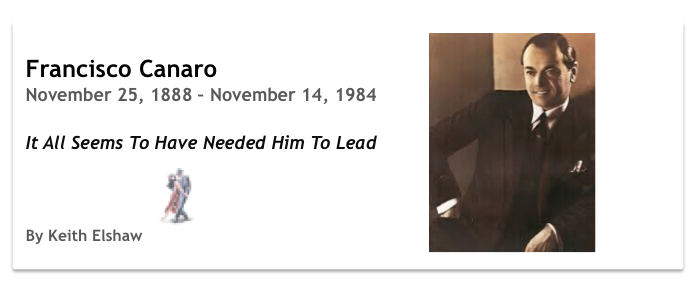What a fix we'd all be in if Francisco Canaro had not strolled across the stage. Would Paris and then Europe have succumbed to the siren call of Argentine tango without him being there with his orquesta for so many months to make it happen? Would tango have meant so much to so many without his compositions that became loved and famous?
Would composers and poets have been able to survive in music without his administrative skills putting an international royalty collection system in place for them?
As a kind of godfather of the tango business, he was looked to as an arbitor to settle disputes. As a commercial juggernaut, he showed what was possible for a creative person to live the life of an music artist.
And as an orchestra leader he made far more recordings than than any one else - a truly prodigous output.
And at the end of it all, over 30 years since he left, (1888 - 1984) a person like me can sit listenng to each recording for hours to improve the audio quality and simply marvel. He didn't "just crank them out" - you can hear in EVERY song that he sought to have an interesting little twist in the arrangement of every record. How I respect that in him. Without knowing anything about him, any person can listen to any of his songs and come away satisfied at how good it is.
Francisco Canaro's music is like a glue you use in programming to stick all the parts together because it recalls the old Tango feel while capturing the sound of the Golden Era. It ranges from sophisticated large orchestras to simple quintet - Quinteto Pirincho - his formation for radio work.
As something of a tango musiciologist, if I was ever asked whose most perfectly demonstrated the utimate in all styles of dance music, tango, vals and milonga, the answer Canaro would be out before you could finsish the question. Of course there are others; but there is only one Canaro wioth such an impressive body of work.
For the world outside of Argentina Canaro is where it all began. He was the one who introduced the tango form to Paris, living there with his orquesta in 1925. He created the whole global tango craze - you could say single-handedly (with his musicians. Brother Rafael stayed on in Paris and seamlessly kept tango happening).
A violinist, Francisco had a prolific period composing between 1908-1920. Some classics of his from that time: La Tablada, Pinta Brava, Nueve Puntos, El Pollito, El Chumayo, Nobleza de Arrabal, Milonga Brava.
Across his catalogue you find quaint old-style tango, candombe and cayengue, and recordings with a drive as exciting as any.
Born in Uruguay, he moved to Buenos Aires at 10 and finally became an Argentine citizen officially in 1940. He had a deep love for candombe, cayengue and milonga and is always at the top of my list for great milonga and vals.
His waltzes, such as Corazon De Oro and Vibraciones De Alma are intoxicating; as are his slow milongas such as Milonga del 900 and Milonga Criolla.
For excitement, the faster milongas: Milonga Brava; La Milonga De Buenos Aires; Reliquias Porteñas, San Benito De Palermo, Parque Patricios.
A leader in many important ways, Francisco was the first person to work in the area of tango fantasia starting in 1928 (Piazzolla before Piazzolla - Astor was 7 years old at the time), elevating tango to a theatrical level it had never aspired to before him. From this period came Halcón Negro among others - kept alive always by the exceptional Gloria and Eduardo Arquimbau. To truly understand, from our era, his importance, you have to immerse yourself in the sound of the music before he came along. What a difference! He had the biggest orchestral sound, travelled the most (ambassador for Tango in Europe and North America), had the most rich and eclectic arrangements (muted trumpet, clarinet, organ).
Beyond making music, Francisco contributed in other important ways. He established and was the first President of SADAIC, the performance rights collection agency, therefore generating income for all composers and authors for the publishing of their works around the world.
I personally also like that he ignored the prejudices of society and delighted in featuring women singers. He lead the way in so many ways.
Like when he sampled Gardel in 1959.
2 Restoration Moments in 1Carlos Gardel had been gone 24 years when, in 1959, Fransisco Canaro took the inventive step of recording band tracks to surround old Gardel recordings with new orchestration. (The two had recorded together in 1930).
Now, to clean them up, I have two layers of record clicks and noise to eliminate - Canaro's record (lp) and the Gardel recordings within it (78). ("Sampling" was thus done in the 50's in Argentina, but they didn't have the ability to clean the old 78's at that time).
Listening now to Canaro's work restored, it sounds quite remarkable. He orchestrated a caress of modern orquesta around the bare voice and guitars of the original late-20's Gardel recordings ... letting us imagine a Carlitos of a later era - with a sexier rhythm.
How Mi Noche Triste sounds after taking out the two sets of noise

